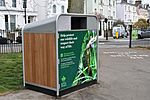Primrose Hill facts for kids
Quick facts for kids Primrose Hill |
|
|---|---|

The view of London from the top of Primrose Hill
|
|
| Lua error in Module:Location_map at line 420: attempt to index field 'wikibase' (a nil value). | |
| Type | Public Park |
| Location | London Borough of Camden, London, UK |
| Nearest city | London |
| OS grid | TQ282838 |
| Area | 25.18 hectares (62.2 acres) |
| Elevation | 64 metres (210 ft) |
| Designated | 1842 |
| Operated by | The Royal Parks |
| Status | Open |
| Public transit access | Swiss Cottage tube station, Chalk Farm tube station |
| Part of | Regent's Park |
| Facilities | Playground and toilets |
| Website | www.royalparks.co.uk |
Primrose Hill is a famous public park in London, England. It is located just north of Regent's Park. This park first opened to everyone in 1842.
The park is named after a natural hill that is 64 metres (210 ft) (about 210 feet) high. This hill is the second highest natural point in the London Borough of Camden. From the top of the hill, you can see amazing views of central London. You can also see areas like Hampstead and Belsize Park to the north. There's even a special stone at the top with words from the poet William Blake carved into it. Because the park is so well-known, the area around it is also called Primrose Hill.
In the park, you can find fun things to do. There's an outdoor gym called the Hill Trim Trail. There's also a children's playground and public toilets. These are all on the south side of the park, close to Primrose Hill bridge. This bridge connects the park to the London Zoo and Regent's Park.
Contents
History of Primrose Hill
Long ago, Primrose Hill was part of a huge hunting ground that belonged to Henry VIII, a famous English king. In 1841, the land became "Crown property." This means it was owned by the King or Queen of England.
A year later, in 1842, a special law called an Act of Parliament was passed. This law made sure that Primrose Hill would always be a public open space for everyone to enjoy. The name "Primrose Hill" has been used since the 1400s. So, it's not named after Archibald Primrose, who was a Prime Minister much later.
Building the Area
In 1816, a canal was built through the Primrose Hill area. Later, in 1838, a railway line was completed. This railway ran in a tunnel right under the hill. It was the very first railway tunnel in London!
By the 1840s, people saw the area as a great place to build new homes. Some land was sold, and new houses were built. Other parts of the land were given to the government in 1841. After 1851, the Crown (the government) worked to improve the land. They drained wet areas and made the ground level. They also added features to turn it into a beautiful "park for the people."
Primrose Hill was historically part of different local areas, including Marylebone, St Pancras, and Hampstead. Today, the park is looked after by The Royal Parks Authority.
Primrose Hill During COVID-19
During the COVID-19 pandemic in London, many people visited Primrose Hill. After some lockdown rules were relaxed in March 2020, large crowds came to the park. Unfortunately, a lot of rubbish was left behind, and people did not always keep a safe distance from each other. Because of this, Primrose Hill had to be temporarily closed for a weekend to help keep everyone safe and clean up the park.
The Primrose Hill District
The area around the park is also called Primrose Hill. It is known for its pretty streets and lovely houses. Many famous people have lived in this district over the years.
Famous People and Buildings
Many well-known people have lived in Primrose Hill. These include writers, artists, and musicians. The area has a special charm with its unique buildings and quiet streets.
See also
 In Spanish: Primrose Hill para niños
In Spanish: Primrose Hill para niños


